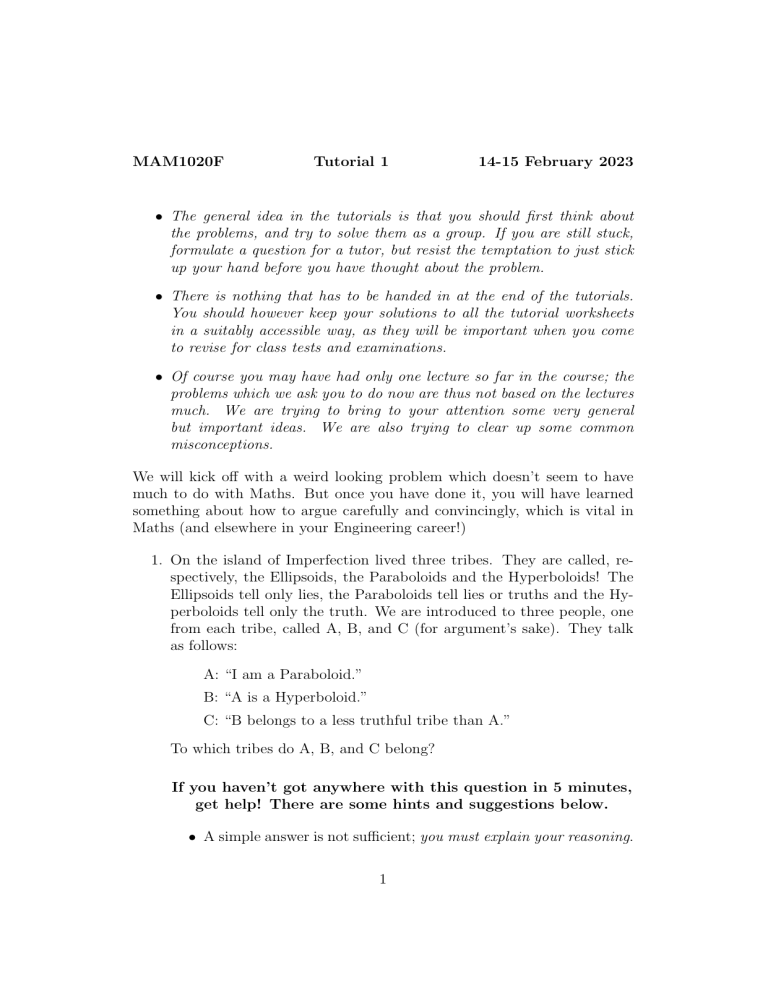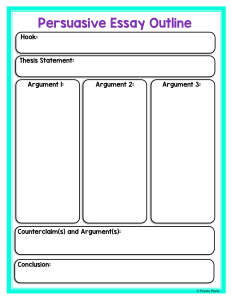
MAM1020F Tutorial 1 14-15 February 2023 • The general idea in the tutorials is that you should first think about the problems, and try to solve them as a group. If you are still stuck, formulate a question for a tutor, but resist the temptation to just stick up your hand before you have thought about the problem. • There is nothing that has to be handed in at the end of the tutorials. You should however keep your solutions to all the tutorial worksheets in a suitably accessible way, as they will be important when you come to revise for class tests and examinations. • Of course you may have had only one lecture so far in the course; the problems which we ask you to do now are thus not based on the lectures much. We are trying to bring to your attention some very general but important ideas. We are also trying to clear up some common misconceptions. We will kick off with a weird looking problem which doesn’t seem to have much to do with Maths. But once you have done it, you will have learned something about how to argue carefully and convincingly, which is vital in Maths (and elsewhere in your Engineering career!) 1. On the island of Imperfection lived three tribes. They are called, respectively, the Ellipsoids, the Paraboloids and the Hyperboloids! The Ellipsoids tell only lies, the Paraboloids tell lies or truths and the Hyperboloids tell only the truth. We are introduced to three people, one from each tribe, called A, B, and C (for argument’s sake). They talk as follows: A: “I am a Paraboloid.” B: “A is a Hyperboloid.” C: “B belongs to a less truthful tribe than A.” To which tribes do A, B, and C belong? If you haven’t got anywhere with this question in 5 minutes, get help! There are some hints and suggestions below. • A simple answer is not sufficient; you must explain your reasoning. 1 • Is your solution the only possible one? You should be able to explain why. • A general hint: it is a good approach to pretend that one of the people is, say, a Hyperboloid, and see what you can deduce from that. If it leads you to a contradiction, you’ve discovered something. • Your answer to this question should be something that we and you can understand. Remember; you will be required to explain things about calculus and other things later in this course, particularly in class test and exams. As an engineer you will be required to explain things to future clients, bosses, co-workers and so on. We take the ability to explain things in this course very seriously. You should too. We turn now to some more “mathematical” stuff: 2. Below are three quite similar statements with “proofs” or “arguments” supporting them. In each case decide: (a) Whether you agree with the statement. Is it true or false? (b) Whether you agree with the argument given for the statement. Is it an acceptable argument or not? You see, there is a difference between the above two things: a result may be true but the supporting arguments for its truth may be wrong. Be prepared to defend your decision about the results and your arguments! (I) Statement: If you square any odd number and divide the answer by 4, the remainder is 1. Argument: Well look at the odd number 3; 32 = 9: if you divide 9 by 4 you get remainder 1. So the statement is true. (II) Statement: All first year students registered for MAM1020F are studying Chemical Engineering. Argument: All the first year Chemical Engineering students I know are registered for MAM1020F, so the statement is true. 2 (If you think this is a ridiculous argument, that is good, but the argument for the last statement (I) was exactly the same, if you think about it, and maybe you were quite tempted by the argument in (I)? ) (III) Statement: If (x − 1)(y − 1) = 1 then x = 2 and y = 2. Argument: If you make x = 2, then x − 1 = 1; similarly, if you make y = 2, then y −1 = 1, so (x−1)(y −1) = 1. So the statement is true. Finally, whatever you decide about each statement, provide what you think is an acceptable valid argument for your decision. 3. Using the above examples, try to answer the following: (a) If you want to disprove a general statement you need to provide what? (b) If you want to prove a general statement you need to provide what? (c) Check your answers with a tutor. 4. Which of the following are true and which are false? √ (a) 9 = 3 and −3. √ √ (b) 9 = 3 or 9 = −3 √ (c) 9 = 3. √ (d) 9 6= −3. (e) If x2 = 9 then x = 3 or x = −3. Once you have decided, check your answer with a tutor ! 5. A list of car registration numbers and owners is drawn up. Do you think this list represents a function? Motivate your answer; there may in fact be more than one correct answer. 6. If x + 1 1 = 4, find x2 + 2 . x x 3 7. Solve the following equations: (a) x4 − 3x2 + 2 = 0 (b) 22x = 64 (c) sin2 x − sin x − 2 = 0 on the interval 0◦ ≤ x ≤ 360◦ 8. Three semicircles fit into a rectangle as shown. The large semicircle has a diameter of 4 and the two small semicircles √ each have a diameter of 2. Show that the area of the rectangle is 8 2. 4





